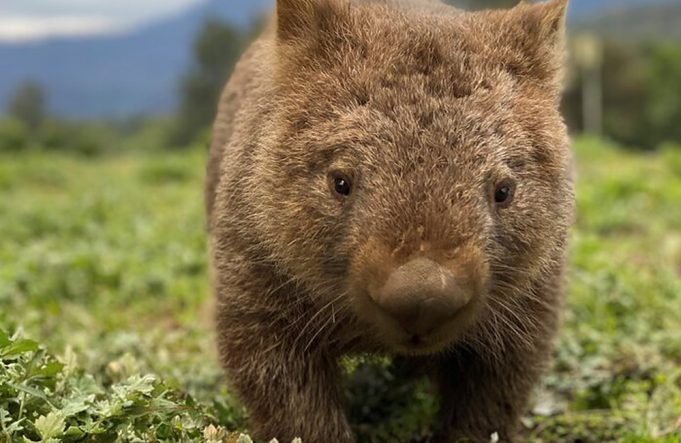Twenty years ago, I saw my first wombat in Melbourne Zoo. It came up to the fence where it regarded me curiously before ambling away again. It was about the most freaking adorable thing I had ever seen, having all the attributes that make a fine animal; round black eyes, giant smooshy nose, stumpy feet, wide-load backside.
I never forgot Womby, and today I had the chance to get even closer to these beloved Australian creatures at Currumbin Wildlife Sanctuary.
Three times a week, the keepers allow two lucky, lucky people to take the lead (literally) of Lee and Janome. These two bundles of chub were both found as orphan babies and are now 18 months old. They are used to being walked on leads, and seemed to enjoy the chance to get out of their enclosure for some fresh plant snacks and a change of scenery. Don’t expect obedience or straight lines, they are wilful and stubborn and tangled leads were all part of the experience.
I was in love with the fact that wombats are super soft in the fur department. Their paws are powerful and more monkey-like than you would expect, and they are still a wild animal who will munch on your shoes (and your hands if given the chance). The keepers advised that wombat nips hurt like crazy, and visitors are not allowed to pick them up. I was a bit upset about not getting the full cuddle service, but in reality I would have just buried my face straight into the soft wombat tummy fur and things would have gone bad very quickly….
Five Wombat Facts
1. Although wombats have a delightful slow waddle going on, they can run at speeds of up to 40 km/ph for short distances. There is an urban legend game that involves finding a wild wombat and goading it into charging towards you, as wombats can only run in a straight line. If you step aside it will be forced to keep running past before it has to stop and turn around to continue its charge. I can now vouch for the fact that this is false. Wombats can and will run in any darn direction they choose to.
2. Wombats are marsupials, and talented burrowers. They have evolved so that their pouch faces towards the back so the wombatlings don’t get covered in soil, and instead have a clear view out from under the tail.
3. Wombat defences include sharp incisors and powerful back legs and claws for kicking. If their burrow is under threat, the wombat will park up with its buttocks outwards and blocking the tunnel entrance. It has a tough skin and barely any tail which makes it very difficult for predators such as dingoes to gain a hold.
4. Wombats are only found in Australia. There are three species, one of which is critically endangered with only 100 or so known to exist. The wombat’s extinct prehistoric relative, Diprotodon, was the size of today’s hippopotamus.
5. Okay okay, wait for it…wombats have SQUARE POO. How do they snap off a cube like that? It is one of nature’s mysteries. I had hoped to see my wombat giving a demonstration, but I was out of luck. Wombats use their droppings as territorial markings and deposit them as a visual signal on top of rocks. Being of a square nature, they are less likely to roll off. Genius!
Where to get your wombat fix
Currumbin Wildlife Sanctuary, Gold Coast, Australia
Price: $35 AUD per person, plus reduced entrance fee to the sanctuary of $35 AUD per adult. Only two walkers allowed at each session, so booking well in advance is advisable.
Time: 3pm on Monday, Wednesday, Saturday














